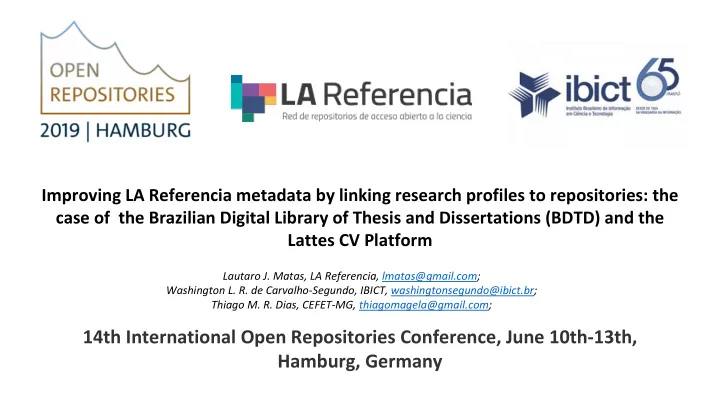

Improving LA Referencia metadata by linking research profiles to repositories: the case of the Brazilian Digital Library of Thesis and Dissertations (BDTD) and the Lattes CV Platform Lautaro J. Matas, LA Referencia, lmatas@gmail.com; Washington L. R. de Carvalho-Segundo, IBICT, washingtonsegundo@ibict.br; Thiago M. R. Dias, CEFET-MG, thiagomagela@gmail.com; 14th International Open Repositories Conference, June 10th-13th, Hamburg, Germany
Introduction This presentation shows a collaborative regional effort on enrich theses metadata by linking repositories with a national CV system : Describe the “ecosystem” of Brazil theses (BDTD) and CV (LATTES) systems Present the results a pilot deduplication experience using a basic algorithm Show how this experience in being integrated into LA Referencia LRHarvester software platform . Lattes BDTD Delivery of Theses CV Enriched Records metadata Records
BDTD – BRAZILIAN DIGITAL LIBRARY OF THESES AND DISSERTATIONS Created in 2002 by IBICT – Brazilian Institute of Information in Science and Technology + 540K full-text documents 114 Brazilian institutions Is part of the oasisbr – Brazilian Portal of Open Access Publications An window to: NDLTD (Network Digital Library of TDs) LA Referencia OpenAIRE
BDTD – BRAZILIAN DIGITAL LIBRARY OF THESES AND DISSERTATIONS Public portal and metasearcher built over the LA Referencia software platform VuFind (Solr search engine) LRHarvester v 3.4 OAI-PMH Provider Local repositories are using different platforms: DSpace 4, 5 and 6 A minor amount is using locally developed platform
Created and supported from 1999 by the National Council of Scientific and Technological Development (CNPq ) +6m records => 99.9% of the researchers in Brazil have a profile in this platform Academic history and researcher profile information Full name Research ID Affiliations Production Theses and dissertations, LATTES RESEARCH PROFILE PLATFORM articles, books, conferences Projects HTTP://LATTES.CNPQ.BR/ Founders
LATTES RESEARCH PROFILE PLATFORM
Trigram string similarity is a method of identifying phrases that have a high probability of being variants of the same original phrase . It is based on representing each phrase by a set of character trigrams. https://ii.nlm.nih.gov/MTI/Details/trigram.shtml BDTD The initial strategy was to calculate the distance for the COLLECTION title and author strings, hypothesis was that the joint probability of two records having high coefficients in the two fields and not being the same record is AND CV LATTES extremely low . LINKING PROOF The strategy proved to be very accurate , but with impractical computational cost, at least for our infrastructure. OF CONCEPT We implemented a Elasticsearch trigram indexing and “More Like This Query” heuristic, given the title of a record, to obtain a small list of possible candidates to be compared with the trigram-based strategy . As a result, now the method can be used to compare two arbitrary collections of millions of records in a few hours .
The Elasticsearch+Trigram-based strategy was applied to the BDTD collection (543,161 metadata records) and compared to a Lattes CV Platform declared thesis collection (1.364.279 records). Additionally, a subset of BDTD collection (87.341 records) that BDTD have the ID Lattes assigned was used as a control set and for error calculation . COLLECTION The was executed using .60 as threshold trigram cosine distance for author and title comparisons, and the candidates were selected AND CV LATTES considering titles with 55% of coincident trigrams for “More Like This” queries. LINKING As result 401.723 BDTD records (73,96%) were identified in the Lattes CV Platform . RESULTS. Regarding the control subset, 65.981 (75,54%) were matched with 6 (0,01%) wrong matches ( Error Type I : positive match for different IDs Lattes). Regarding Error Type II (not matched with same Lattes ID) 17.085 records (19,56%) were missed . A careful analysis of the data showed that most cases of Error Type II correspond to titles declared in different languages (English versus Portuguese).
LA REFERENCIA NETWORK – 10 COUNTRIES AND GROWING
LA REFERENCIA AGGREGATION MODEL I.R. I.R. I.R. OAI-PMH OAI-PMH OAI-PMH Country Country Country Aggregator Aggregator Aggregator Node Node Node OAI-PMH OpenAire and others LAReferencia Aggregator Node
6 years of development (2013-2019->), easy to install / maintain Scalable: runs in low end laptops or across multiple servers in distributed mode GPL 3.0 License – Growing development community LA Currently supporting large repository networks (IBICT/BRASIL) REFERENCIA Harvesting/validation/transformation/indexing: repositories LRHARVESTER 1.5+ Million records Multiple metadata schemas ( standard o custom SOFTWARE OpenAire 3.0 (4.0 work in progress) compatible Metatata harvesting / validation / transformation OpenAIRE Distributed usage statistics and broker as a service integration ( work in progress 2019) Data repositories aggregator pilot (end of 2019)
LA REFERENCIA LRHARVESTER ARCHITECTURE 4.0 Build, enrich and store an entity-relation (cerif like) model based on the different metadata sources (literature repositories, aggregators, API´s, CV´s, founders metadata) Use the entity-relation model to curate and enrich metadata. Interoperate with original sources (and actors) to provide feedback. Use the entity-relation model to feed a service API and interoperate with other system and services in S&T ecosystem (CV´s, CRIS)
LA REFERENCIA – OPENAIRE INTEGRATION Broker as a service integration – Consume events / Integration into national network dashboard (to be developed during 2019/2020) * Slides by Paolo Manghi at DI4R2018
Configurable Entity-Relation Meta Model (DB stored) – BETA Entity-Relation Model - 2019 instantiation (OpenAire4/CRIS) - WIP feeding the model from metadata – Harvester Workers CRUD Rest API / HATEOAS (content) LRHARVESTER Public REST API Indexing (SOLR / ELASTICSEARCH) / REST API (search) 3.5/4.0 Model enrichment and entity deduplication 2019/2020 Repository administrator dashboard 2019 (validation results, broker notifications, statistics) ROADMAP Metadata acquisition (other sources than OAI-PMH) - 2020 CRIS Sources Implement Resource Sync API´s (ORCID, NATIONAL DATA) Large DUMPs loading (OpenAIRE Graph, ORCID)
LA REFERENCIA LRHARVESTER Better integration with CV and CRIS Systems (CVLattes, VIVO, DSPACE CRIS, 4.0 POTENTIAL SERVICES ORCID) OpenAIRE Broker event delivery to national networks and repositories OpenAIRE Graph: dump loading and integration into entity model Metadata enrichment for building indicators and decision making tools. Metadata curation and enrichment at repository level OpenAIRE 3.0 to 4.0 migration services for repositories Regional and national usage statistics aggregator portals
. Thank you !! Lautaro J. Matas, LA Referencia, lmatas@gmail.com; Washington L. R. de Carvalho-Segundo, IBICT, washingtonsegundo@ibict.br
Recommend
More recommend